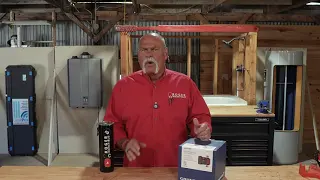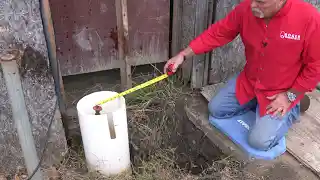When working with copper pipes—whether for plumbing, HVAC, or specialized piping—two major joining methods stand out: soldering (often called “soft solder”) and brazing (sometimes called “silver solder”). Both create strong, leak-free connections by melting metal into the joint. Yet, the temperature ranges, filler materials, and applications differ. To see how each holds up under extreme pressure, we ran a real-world pressure test: one joint soldered, another brazed, and then subjected them to thousands of pounds of force in a blast chamber. The results might surprise you.
Understanding Soldering vs. Brazing
Temperature and Filler Metals
- Soldering: Uses a filler alloy (often tin-based) that melts below roughly 840°F. Because of its relatively low melting point, it’s called “soft solder.” When done correctly, the filler is drawn into the joint by capillary action, forming a water-tight seal.
- Brazing: Involves higher heat—above 840°F—using a “hard” filler metal. Common brazing rods (like Stay-Silv or a BCuP alloy) contain silver, copper, and sometimes phosphorus. The result is a stronger, more rigid joint than soft solder.
Common Uses
- Soldering: Historically standard for potable water lines in residential and commercial buildings, especially before PEX and press fittings became popular. Soldering is still taught widely, and many plumbing codes allow it for copper lines.
- Brazing: Required by many medical gas codes to ensure stronger joints that reduce pinhole risk. Also used in some under-slab repairs for added structural integrity. HVAC technicians frequently braze copper refrigerant lines as well.
Flux or No Flux?
- Soldering: Requires flux, which cleans the metal surface and promotes better flow of the solder. Without flux, oxidation can prevent solder from bonding well.
- Brazing: Often flux-free if using a phosphorus-containing rod (like BCuP). The high heat can handle minor oxidation, though some rods and situations still use flux for better surface cleaning.
Setting Up the Test
We prepared two identical half-inch copper assemblies, each about the same length:
- Solder Joint: A copper pipe with a male adapter on one end and a female adapter on the other. We used standard tin-lead-free solder and flux, heating under 840°F.
- Braze Joint: Another copper pipe with the same adapters but joined using a high-temperature silver-based rod (BCuP type). The heat required is much greater—over 840°F—and no flux was used in the demonstration.
After letting both cool, we threaded each assembly into caps and fittings so they could be connected to a hydrostatic pump. The plan: see if either joint failed under extreme internal pressure.
Step-by-Step Soldering
- Clean and Prep
Polishing both the pipe exterior and fitting interior is crucial. We used an abrasive cloth for the pipe and a fitting brush for the socket. - Flux Application
Applied a thin coat of flux around the pipe end and inside the fitting. The flux helps remove oxidation and ensures the solder flows properly. - Assembly
Slid the fitting onto the pipe, creating a snug, aligned joint. - Heating
With a small torch tip, we focused flame on the fitting first, moving it around to heat evenly. The temperature must be high enough to draw the solder in but not so hot that flux burns away entirely. - Applying Solder
Once the metal reached the right temperature (indicated by how the flux bubbles and the solder tip melts on contact), we touched the solder to the joint. It flowed around by capillary action. - Cooling and Wiping
Let the joint cool briefly before gently wiping off any excess solder or residue.
Step-by-Step Brazing
- Clean and Prep
As with soldering, we cleaned the pipe and fitting thoroughly. - Dry Assembly
Since this demonstration used a BCuP rod with phosphorus, no flux was needed. We fit the adapter onto the pipe dry. - Higher Heat
Brazing demands a larger or hotter torch tip (for example, a Turbo Torch with an A-5 tip). Temperatures often exceed 1,200–1,500°F. This intense heat ensures the brazing rod fully bonds to copper. - Apply Filler
Once the fitting was hot enough, we touched the rod to the joint. The filler liquefied and wicked into the seam. Brazing can fill the entire socket, but in some situations—like med gas—you’d fully “cap” the joint with a big fillet for maximum strength. In our test, we just ensured enough filler was drawn in for a sound seal. - Cool Down
Brazed joints remain hot longer, so extra caution is needed. No immediate wiping is typical because the filler is hotter and more fluid.
The Pressure Test
The Setup
We have a custom “blast chamber” connected to a hydrostatic pump capable of pushing water pressure up to around 10,000 PSI. For context, normal house pressure is rarely over 80–100 PSI. Even high municipal lines might see 200–300 PSI in unusual cases.
First: The Braze
We connected the brazed assembly, bled out air, and began increasing pressure. As it climbed past 5,000 PSI, we braced for a potential blowout. The gauge soared—6,000, 7,000 PSI, still no leak. Then at around 7,000+ PSI, the copper pipe itself burst. The joint remained intact; the metal pipe was the weak link.
Next: The Solder
We expected it to fail sooner, since soft solder has a lower melting point and is typically considered weaker. Again, the gauge shot upward, surpassing 6,000 PSI, heading near 7,000. Suddenly, the copper tube burst wide open, again leaving the solder joint itself unbroken.
Results
Both joints survived well beyond normal plumbing or HVAC pressures. Instead of a fitting separation, the copper tube literally split from excessive stress. While brazing is indeed stronger in theory, the real limitation is often the pipe’s own yield strength, not the filler metal.
Solder vs. Braze: Practical Differences
- Typical Applications
- Solder: Domestic water lines, most plumbing fixtures, and smaller copper runs in moderate-pressure systems.
- Braze: Medical gas lines, high-pressure HVAC refrigerant lines, certain under-slab repairs requiring extra structural integrity.
- Cost and Complexity
- Soldering is simpler, requires lower heat, and is widely taught to apprentices.
- Brazing rods cost more, and you need a hotter torch setup with more skill to avoid overheating or damaging the copper.
- Code Requirements
- Many plumbing codes allow soldering for residential water lines.
- Medical gas lines or certain high-pressure lines usually must be brazed by code, often with 100% or partial nitrogen purge.
- Heat-Related Concerns
- Soldering is less likely to anneal or weaken copper if done quickly and properly.
- The extra heat in brazing can be an advantage for strength but also calls for caution around flammable surroundings and existing seals.
Practical Takeaways
- Strength: Both soldered and brazed joints exceed the pressure rating of typical domestic copper lines. In our test, the copper itself failed first around 7,000 PSI.
- Choose Based on Application: Use brazing in specialized or code-required situations. Otherwise, soldering is perfectly fine for normal household pressures.
- Skill Matters: Bad technique in either method causes leaks at far lower pressures. Proper cleaning, consistent heat, and suitable filler are key.
- Excess Heat: Brazing is best left to those trained in it—temperature control is more critical, and you can damage pipe or burn flux if not careful.
FAQ
Q: Does soldering eventually fail under high temperatures in real use?
A: Typically, no. Residential water lines don’t see anywhere near the 6,000+ PSI from our test. The same goes for typical temperature ranges in home water systems.
Q: Why do medical gas codes require brazing if solder is so strong?
A: Medical gas lines demand higher joint integrity and minimal risk of pinhole leaks. Brazing’s more robust bond is considered extra insurance where human lives depend on it.
Q: Is brazing always better?
A: Not necessarily. It’s stronger but also more time-consuming and expensive. For standard domestic water lines under 150 PSI, solder’s more than sufficient when done right.
Q: Will push-to-connect or press fittings survive the same pressures?
A: Likely not up to 7,000 PSI. They’re rated within typical household pressures plus a safety margin, but this extreme range is beyond normal application.
Conclusion
Whether you solder or braze, a well-made copper joint can handle astonishing pressures far above everyday plumbing demands. In our test, both soft-soldered and brazed fittings held strong until the copper pipe ruptured around 7,000 PSI. That said, each method has its place:
• Solder: Perfect for typical potable water lines, faster and easier for most plumbers.
• Braze: Essential for medical gas, high-pressure refrigerant lines, or certain structural repairs.
So unless your local code or job spec calls for brazing, don’t fear that a solder joint is “too weak.” As demonstrated, it’ll likely exceed your copper pipe’s bursting point. Just remember to clean thoroughly, use the right torch technique, and let each joint cool properly before testing or pressurizing. With good craftsmanship, both methods deliver rock-solid, leak-free results.




